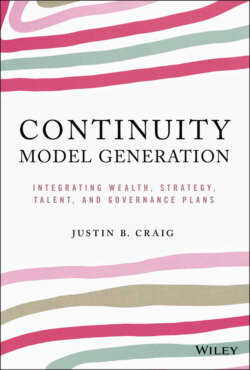Читать книгу Continuity Model Generation - Justin B. Craig - Страница 16
Principal Cost Theory
ОглавлениеAn additional, very useful component in the theoretical understanding of family enterprises, and how they improve the chances of continuity, is principal cost theory (Goshen and Squire 2010).
The two major cost dimensions or components of principal cost theory are conflict and competence (Illustration 5). The argument here is something that has long been overlooked: that there are costs in the appointment of principals. Where these costs manifest in the continuity model generation perspective is when owners are ill-prepared for the responsibility of ownership. This is also the case for directors, but that is covered largely by the agency cost argument. Regardless, understanding or appreciating that owners are potentially compromising their potential by falling victim to one or both of these principal costs characteristics is important.
Like many of the dimensions included in the 21 frameworks, the dimensions of conflict and competence are easy to interpret, remember, and explain. These two dimensions and how they apply in family enterprise are fundamental for those committed to continuity. Indeed, the primary objective as a continuity model generation member is to do whatever it takes to put the family enterprise in position for seamless continuation. That is not to say this is a simple task and there won't be plenty of opportunity to engage in conflict. For example, not everyone will be convinced that the conversation should move from traditional succession planning to a new mindset evolving toward Continuity Model Generation; there will be pushback. Expecting this pushback and framing it in terms of the principal cost is a simple solution.
Similarly, confusion around the concept of competence is likely and should be anticipated. The solution lies in explaining that costs will be incurred in the ownership group if people are not prepared for the responsibilities of ownership. This does not point the finger at any one person but alerts the collective of the issue, which can be addressed through education and communication. In reality, this is not a hard sell. As will become more evident throughout this book, Continuity Model Generation proponents seek a fresh, unifying approach to reduce conflict and tension within, between, and among stakeholders in the family enterprise system. This conflict and tension, in principal–cost theoretical terms, is explainable through the dimensions of (i) conflict of interest, and (ii) individual competency, both of which can be addressed through systematic education and communication.
Illustration 5 PRINCIPAL COST
